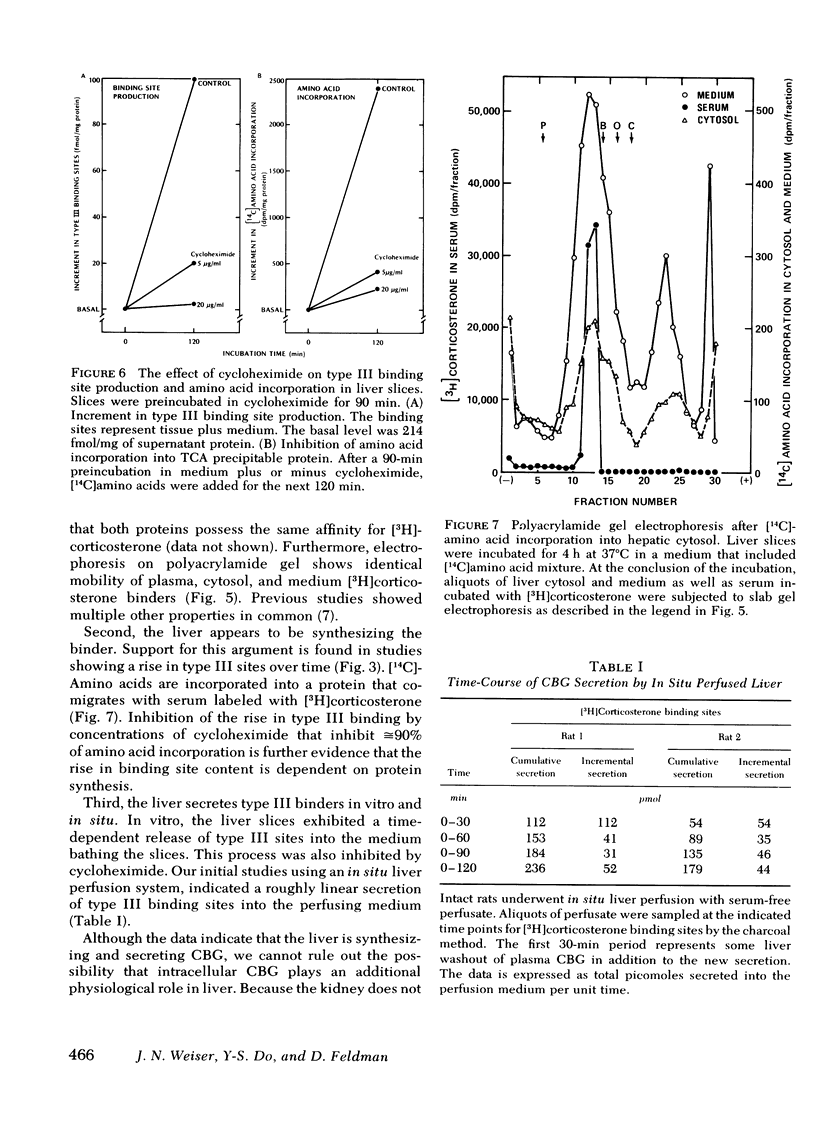Abstract
Classical glucocorticoid receptors (type II) have a high affinity for synthetic and natural glucocorticoids. We have previously demonstrated an additional binding site in kidney cytosol (type III) which has a high affinity for corticosterone but a low affinity for dexamethasone. In many ways, this binder resembles plasma corticosteroid-binding globulin (CBG). The first goal of this study was to determine the organ distribution of the type III binding sites. Cytosol was prepared from isolated cells to avoid plasma contamination. Of the tissues examined, type III sites were found only in liver and kidney; sites were absent from thymocytes, IM-9 lymphocytes, adipocytes, and bone cells. The second goal of this study was to ascertain whether CBG is synthesized in liver and kidney. Liver and kidney slices were incubated in vitro and the concentration of type III sites was seen to rise in hepatic cytosol and incubating medium but not kidney. To verify the impression that liver was synthesizing and secreting CBG, the following experiments were performed: (a) To demonstrate that type III sites were CBG, steroid-binding profiles and migration on polyacrylamide gel electrophoresis were shown to be identical for hepatic type III sites and serum. (b) To indicate that the rise in type III sites was dependent on protein synthesis, it was shown that cycloheximide blocked the appearance of new type III sites. (c) To establish that the type III sites were being secreted, in situ liver perfusion experiments showed time-dependent release of new sites into the perfusate. In conclusion, liver synthesizes and secretes type III sites, a finding previously suspected but never proved. The presence of type III sites in kidney remains to be explained.
Full text
PDF






Selected References
These references are in PubMed. This may not be the complete list of references from this article.
- Amaral L., Lin K., Samuels A. J., Werthamer S. Human liver nuclear transcortin. Its postulated role in glucocorticoid regulation of genetic activity. Biochim Biophys Acta. 1974 Sep 5;362(2):332–345. doi: 10.1016/0304-4165(74)90226-8. [DOI] [PubMed] [Google Scholar]
- Bradford M. M. A rapid and sensitive method for the quantitation of microgram quantities of protein utilizing the principle of protein-dye binding. Anal Biochem. 1976 May 7;72:248–254. doi: 10.1016/0003-2697(76)90527-3. [DOI] [PubMed] [Google Scholar]
- Chen T. L., Aronow L., Feldman D. Glucocorticoid receptors and inhibition of bone cell growth in primary culture. Endocrinology. 1977 Mar;100(3):619–628. doi: 10.1210/endo-100-3-619. [DOI] [PubMed] [Google Scholar]
- Chen T. L., Feldman D. Distinction between alpha-fetoprotein and intracellular estrogen receptors: evidence against the presence of estradiol receptors in rat bone. Endocrinology. 1978 Jan;102(1):236–244. doi: 10.1210/endo-102-1-236. [DOI] [PubMed] [Google Scholar]
- De Kloet E. R., McEwen B. S. A putative glucocorticoid receptor and a transcortin-like macromolecule in pituitary cytosol. Biochim Biophys Acta. 1976 Jan 14;421(1):115–123. doi: 10.1016/0304-4165(76)90175-6. [DOI] [PubMed] [Google Scholar]
- Feldman D., Funder J. W., Edelman I. S. Evidence for a new class of corticosterone receptors in the rat kidney. Endocrinology. 1973 May;92(5):1429–1441. doi: 10.1210/endo-92-5-1429. [DOI] [PubMed] [Google Scholar]
- Feldman D., Funder J. W., Edelman I. S. Subcellular mechanisms in the action of adrenal steroids. Am J Med. 1972 Nov;53(5):545–560. doi: 10.1016/0002-9343(72)90152-0. [DOI] [PubMed] [Google Scholar]
- Feldman D., Loose D. Glucocorticoid receptors in adipose tissue. Endocrinology. 1977 Feb;100(2):398–405. doi: 10.1210/endo-100-2-398. [DOI] [PubMed] [Google Scholar]
- Funder J. W., Feldman D., Edelman I. S. Glucocorticoid receptors in rat kidney: the binding of tritiated-dexamethasone. Endocrinology. 1973 Apr;92(4):1005–1013. doi: 10.1210/endo-92-4-1005. [DOI] [PubMed] [Google Scholar]
- Funder J. W., Feldman D., Edelman I. S. The roles of plasma binding and receptor specificity in the mineralocorticoid action of aldosterone. Endocrinology. 1973 Apr;92(4):994–1004. doi: 10.1210/endo-92-4-994. [DOI] [PubMed] [Google Scholar]
- Giannopoulos G. A comparative study of receptors for natural and synthetic glucocorticoids in fetal rabbit lung. J Steroid Biochem. 1976 Aug;7:553–559. doi: 10.1016/0022-4731(76)90076-5. [DOI] [PubMed] [Google Scholar]
- Koblinsky M., Beato M., Kalimi M., Feigelson P. Glucocorticoid-binding proteins of rat liver cytosol. II. Physical characterization and properties of the binding proteins. J Biol Chem. 1972 Dec 25;247(24):7897–7904. [PubMed] [Google Scholar]
- Koch B., Lutz-Bucher B., Briaud B., Mialhe C. Glucocorticoid binding to plasma membranes of the adenohypophysis. J Endocrinol. 1977 May;73(2):399–400. doi: 10.1677/joe.0.0730399. [DOI] [PubMed] [Google Scholar]
- Koch B., Lutz B., Briaud B., Mialhe C. Heterogeneity of pituitary glucocorticoid binding evidence for a transcortin-like compound. Biochim Biophys Acta. 1976 Sep 24;444(2):497–507. doi: 10.1016/0304-4165(76)90393-7. [DOI] [PubMed] [Google Scholar]
- Litwack G., Filler R., Rosenfield S. A., Lichtash N., Wishman C. A., Singer S. Liver cytosol corticosteroid binder II, a hormone receptor. J Biol Chem. 1973 Nov 10;248(21):7481–7486. [PubMed] [Google Scholar]
- Mayer M., Kaiser N., Milholland R. J., Rosen F. Cortisol binding in rat skeletal muscle. J Biol Chem. 1975 Feb 25;250(4):1207–1211. [PubMed] [Google Scholar]
- Milgrom E., Baulieu E. E. Progesterone in uterus and plasma. I. Binding in rat uterus 105,000 g supernatant. Endocrinology. 1970 Aug;87(2):276–286. doi: 10.1210/endo-87-2-276. [DOI] [PubMed] [Google Scholar]
- Strum J. M., Feldman D., Taggart B., Marver D., Edelman I. S. Autoradiographic localization of corticosterone receptors (type III) to the collecting tubule of the rat kidney. Endocrinology. 1975 Sep;97(3):505–516. doi: 10.1210/endo-97-3-505. [DOI] [PubMed] [Google Scholar]
- Van Baelen H., Bouillon R., De Moor P. Binding of 25-hydroxycholecalciferol in tissues. J Biol Chem. 1977 Apr 25;252(8):2515–2518. [PubMed] [Google Scholar]
- Werthamer S., Samuels A. J., Amaral L. Identification and partial purification of "transcortin"-like protein within human lymphocytes. J Biol Chem. 1973 Sep 25;248(18):6398–6407. [PubMed] [Google Scholar]


